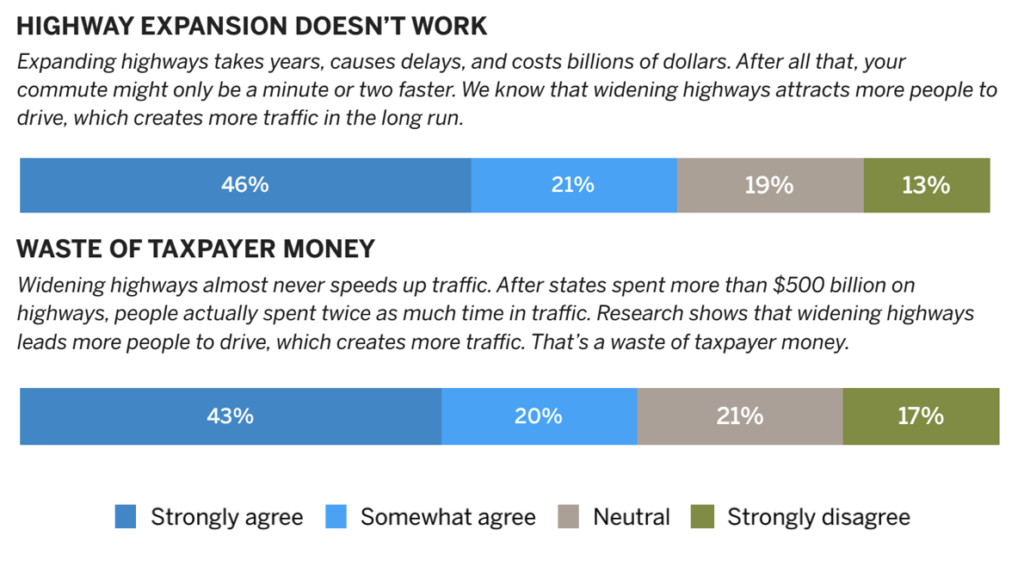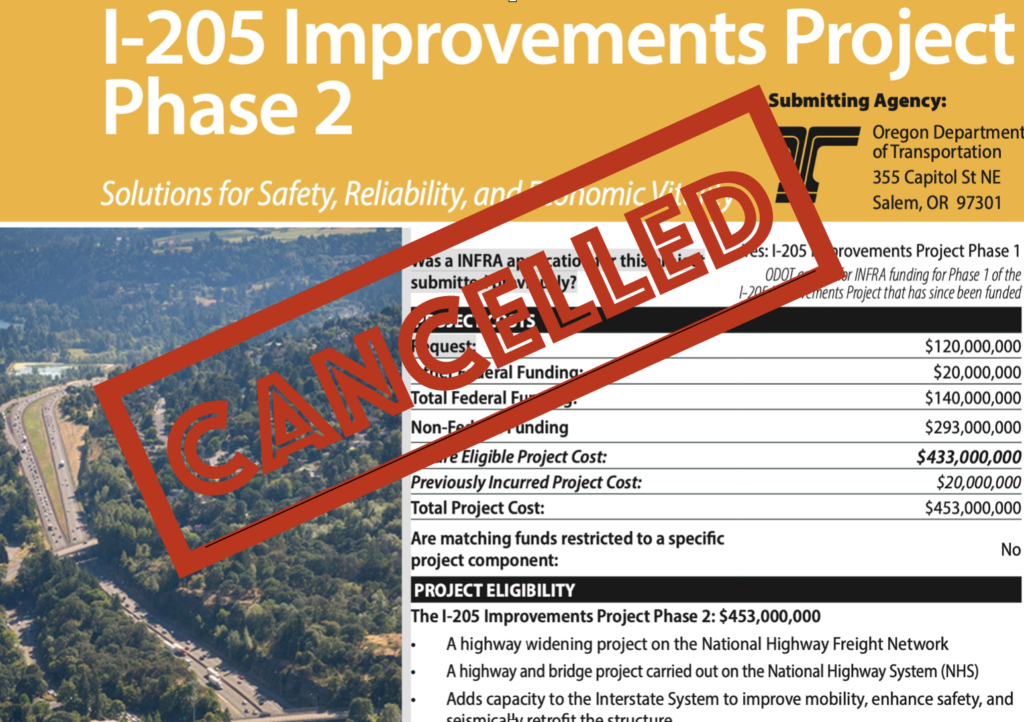What City Observatory did this week
Scratch one flat top! That was the famous cry of US Naval aviators, when, early in World War II they chalked up their first victory, sinking the Japanese aircraft carrier Shoho. Portland’s freeway fighters, who’ve been battling for years against the multi-billion dollar expansion plans of the Oregon Department of Transportation marked their first big victory this week, as ODOT cancelled plans for the $450 million I-205 freeway widening south of Portland. ODOT staff finally concede what freeway opponents have been saying for years: the agency simply can’t afford the project, and besides, it won’t work to reduce congestion.
The I-205 Phase 2 project is dead—although in bureaucratic parlance it’s merely “indefinitely postponed.” Also in serious jeopardy is the I-5 Rose Quarter Freeway widening, a project whose cost has ballooned to $1.9 billion and for which Oregon DOT has no clearly identified source of funding. Portland’s freeway fight will continue.
Must Read
Americans Understand Induced Travel, even if highway departments don’t. Upton Sinclair’s axiom “It is difficult to get a man to understand something, when his salary depends on his not understanding it” holds with a vengeance for highway engineers and boosters. But most Americans, who aren’t in the thrall of the highway industrial complex, now recognize that round after expensive round of highway construction has done nothing to reduce congestion. Transportation for America’s national survey asked a representative sample of Americans a battery of questions related to traffic, transportation, sustainability and public policy. We want to highlight one key finding: A clear majority of Americans now recognize that widening highways is a futile and costly approach to transportation.
 About two-thirds of respondents agreed strongly or somewhat that highway expansion in ineffective in reducing traffic congestion. More than three fifths of respondents agreed that highway expansion is a waste of taxpayer money. Our friends and Seattle’s Urbanist have a terrific write up of the report as well.
About two-thirds of respondents agreed strongly or somewhat that highway expansion in ineffective in reducing traffic congestion. More than three fifths of respondents agreed that highway expansion is a waste of taxpayer money. Our friends and Seattle’s Urbanist have a terrific write up of the report as well.
Rule of the Road: Priority for Pedestrians. Paris Mayor Anne Hidalgo has made prodigious strides in re-shaping transport in Paris. As she says:
Faced with the climate emergency, we are adapting Paris and radically changing the way we get around. Parisians have understood this well! In record time, they massively appropriated the cycle paths. The results are there: in 10 years, car traffic has decreased by 40%, and pollution by 45%. Paris now has more than 1,120 km of cycle paths, compared to 200 km in 2001.
That’s led to some complaints that the city has become more challenging for those on foot. Hidalgo is unequivocal: Priorite absolue pour les pietons: Absolute priority for pedestrians. The city has announced new measures to create pedestrian zones around schools, to better enforce traffic laws protecting pedestrians, and eliminate cycling on sidewalks.
Making cities work well requires a radical re-thinking of transportation priorities. Bold leaders like Paris are showing that positive change is possible.
New Knowledge
More evidence for induced travel. Add another study to the growing pile of literature documenting the phenomenon of induced travel—widening roads, ostensibly to reduce congestion, simply encourages more people to travel on the expanded roadway. This latest evidence comes from England, where motorway authorities widened a stretch of the key M25 roadway from three lanes in each direction to four by allowing vehicles to drive on the road’s paved shoulder.
A benefit-cost analysis prepared for the project predicted that it would produce significant benefits to business and commuter travel by speeding traffic and reducing travel times. But instead, as always happens, the expanded roadway simply attracted more trips. As the study concludes:
. . . the economic benefits to longer distance business users anticipated from road widening are negated by the use made of the increased capacity by local road users for short trips of less economic value.
The study’s author also concludes that the induced travel effect is accelerated by the availability of real time traffic information and “sat-nav”—satellite navigation—systems in cars. The availability of additional space and (temporarily) faster routes, prompts these systems to route more vehicles onto the expanded roadway.
The study has several important implications. First, the travel time “benefits” counted in benefit-cost studies used to justify widening projects are non-existent and illusory. Accurate benefit-cost analyses would show expanded roadways are a value-destroying proposition. Second, you can’t alleviate congestion by providing more roadway capacity: More roads simply prompt more driving, meaning more pollution and no reduction in congestion.
David Metz, “Digital navigation negates the economic benefits of road widening: The case of the M1 motorway,” Transportation Research Part A: Policy and Practice, Volume 174, 2023, 103749,,
https://doi.org/10.1016/j.tra.2023.103749.
(https://www.sciencedirect.com/science/article/pii/S0965856423001696)
https://ucl.scienceopen.com/hosted-document?doi=10.14324/111.444/ucloe.000034
(hat tip to @DavidZipper).
In the news
City Observatory Director Joe Cortright was nominated as one of Planetizen’s “most influential urbanists” for 2023. You can see the entire list of nominees and register your votes here.



